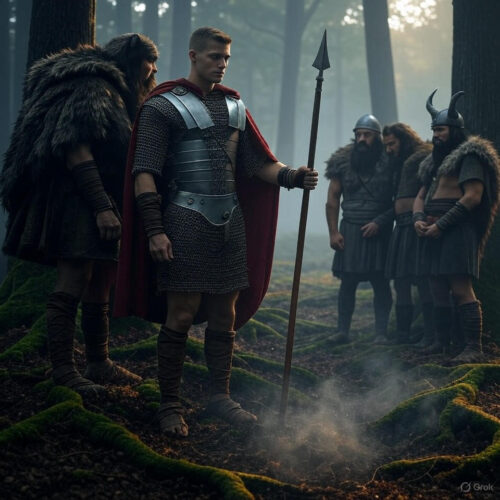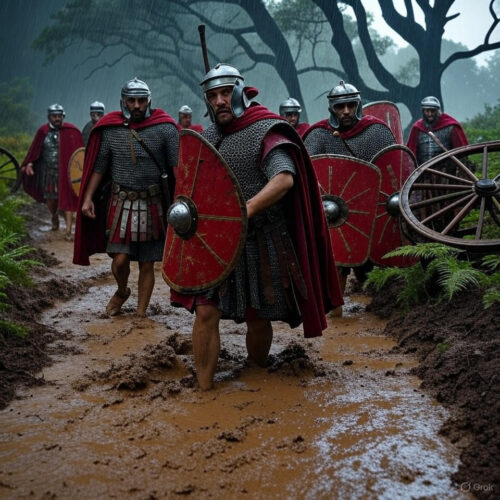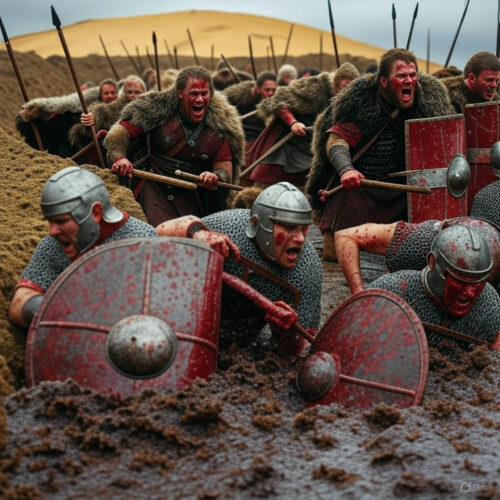The dense, mist-shrouded woods of ancient Germania hid more than just towering oaks and tangled underbrush—they concealed a turning point in human history. On September 11, 9 AD, the final echoes of battle cries faded in the Teutoburg Forest, marking the end of one of the Roman Empire’s most catastrophic defeats. This wasn’t just a clash of swords and shields; it was a masterful display of strategy, betrayal, and defiance that halted the unstoppable march of Rome and reshaped the map of Europe. In this blog, we’ll dive deep into the gritty details of this ancient ambush, exploring the backgrounds, the brutal play-by-play, and the rippling consequences that still influence our world today. And while history’s lessons are timeless, we’ll wrap up by drawing direct, actionable insights from this event—showing how you can channel the spirit of those Germanic warriors to overcome your own modern “empires” of challenges. Get ready for a journey that’s equal parts epic tale and empowering blueprint.
Let’s set the stage with the world of 9 AD. The Roman Empire, under Emperor Augustus, was at its zenith, a colossal machine of conquest that had swallowed vast swaths of Europe, North Africa, and the Middle East. Augustus, born Gaius Octavius, had transformed the crumbling Roman Republic into an imperial powerhouse after defeating Mark Antony and Cleopatra at the Battle of Actium in 31 BC. His reign brought the Pax Romana, a period of relative peace and prosperity, but it was built on relentless expansion. To the east of the Rhine River lay Germania, a land of fierce, tribal peoples who lived in scattered villages, worshipped nature gods, and valued personal honor above all. These tribes—the Cherusci, Bructeri, Marsi, and others—were not unified; they squabbled among themselves as often as they raided Roman outposts. But Rome saw opportunity in their disunity, aiming to incorporate Germania into the empire as a new province, complete with taxes, roads, and legions to enforce order.
The roots of the Teutoburg disaster trace back decades. Julius Caesar had first probed the Rhine during his Gallic Wars (58–50 BC), crossing the river twice in daring but short-lived expeditions. He described the Germans in his Commentarii de Bello Gallico as tall, brave warriors who fought with reckless abandon, often naked or clad in animal skins to intimidate foes. Caesar’s accounts painted them as barbarians, justifying future invasions. After Caesar’s assassination in 44 BC, Rome’s focus shifted inward, but by 12 BC, Augustus dispatched his stepson Drusus Nero to conquer the region. Drusus led brutal campaigns, subduing tribes and establishing bases along the Lippe and Ems rivers. He even reached the Elbe, but died in 9 BC after falling from his horse—a bad omen, some said. His brother Tiberius continued the work, and by 4 AD, Rome had a loose hold on parts of Germania, with garrisons and alliances forged through hostages and education.
Enter Publius Quinctilius Varus, the ill-fated Roman commander. Born around 46 BC into a patrician family, Varus was more politician than soldier. He had served as consul in 13 BC alongside Tiberius and governed Africa and Syria, where he amassed wealth but also notoriety for harsh taxation—crucifying 2,000 rebels in Judea after Herod the Great’s death. In 7 AD, Augustus appointed him governor of Germania, tasking him with consolidating control. Varus arrived with three legions—the XVII, XVIII, and XIX—totaling about 15,000 heavy infantry, plus 5,000 auxiliaries, cavalry, and camp followers, bringing the force to around 20,000–25,000 people. These legions were the backbone of Rome’s military: disciplined, armored in segmented lorica segmentata (though chain mail was more common then), armed with gladius short swords, pilum javelins, and large scutum shields. They marched in precise formations, built fortified camps nightly, and engineered roads through wilderness.
Opposing Varus was Arminius, a name that would become synonymous with treachery and heroism. Born around 17 BC to the Cherusci chief Segimer, Arminius (Hermann in German) was taken as a hostage to Rome as a boy, a common practice to ensure tribal loyalty. He received a Roman education, learned Latin, and served as an auxiliary officer in the legions, earning citizenship and equestrian rank. By 9 AD, he commanded a Cherusci detachment under Varus, who trusted him implicitly—calling him a friend and dining with him. But Arminius harbored deep resentment against Roman domination. Secretly, he united rival tribes, forging a coalition of perhaps 12,000–18,000 warriors. Germanic fighters were lightly equipped: wooden shields, framea spears (versatile for throwing or thrusting), axes, and clubs. Wealthier ones had iron helmets and mail, but most relied on speed, terrain knowledge, and ferocity. Arminius’s father-in-law, Segestes, warned Varus of the plot, but Varus dismissed it as jealousy over Arminius marrying Segestes’s daughter Thusnelda against his wishes.
 The summer of 9 AD was tense. Varus based at Haltern am See on the Lippe River, collecting taxes and adjudicating disputes, which alienated tribes with Roman legal arrogance. Reports of uprisings in the west drew Varus out in early September. He planned to march his army back to winter quarters at Vetera (modern Xanten) on the Rhine, a 200-kilometer trek. Arminius suggested a detour north to quell a fabricated rebellion, leading the Romans into the Teutoburg Forest—a 100-kilometer stretch of hills, bogs, and dense woods near modern Osnabrück. The forest was no picnic: narrow paths, sudden ravines, and thick foliage perfect for ambushes. Varus’s column stretched 15–20 kilometers, burdened with wagons, women, children, and slaves—more migration than military march.
The summer of 9 AD was tense. Varus based at Haltern am See on the Lippe River, collecting taxes and adjudicating disputes, which alienated tribes with Roman legal arrogance. Reports of uprisings in the west drew Varus out in early September. He planned to march his army back to winter quarters at Vetera (modern Xanten) on the Rhine, a 200-kilometer trek. Arminius suggested a detour north to quell a fabricated rebellion, leading the Romans into the Teutoburg Forest—a 100-kilometer stretch of hills, bogs, and dense woods near modern Osnabrück. The forest was no picnic: narrow paths, sudden ravines, and thick foliage perfect for ambushes. Varus’s column stretched 15–20 kilometers, burdened with wagons, women, children, and slaves—more migration than military march.
 The battle unfolded over three to four days, starting around September 8. As the Romans entered the forest, Arminius excused himself to “gather allies,” taking his auxiliaries but leaving spies. The first attacks were hit-and-run: Germanic warriors hurled spears from trees and hillsides, targeting stragglers. Roman discipline held, but a massive thunderstorm turned paths to mud, bogging down wagons and scattering formations. “The violent downpour…prevented them from advancing,” wrote historian Cassius Dio in his Roman History (written around 230 AD). By nightfall, the Romans built a hasty camp, burning excess baggage to lighten the load.
The battle unfolded over three to four days, starting around September 8. As the Romans entered the forest, Arminius excused himself to “gather allies,” taking his auxiliaries but leaving spies. The first attacks were hit-and-run: Germanic warriors hurled spears from trees and hillsides, targeting stragglers. Roman discipline held, but a massive thunderstorm turned paths to mud, bogging down wagons and scattering formations. “The violent downpour…prevented them from advancing,” wrote historian Cassius Dio in his Roman History (written around 230 AD). By nightfall, the Romans built a hasty camp, burning excess baggage to lighten the load.
September 9 saw intensified assaults. The column pushed toward Kalkriese Hill, a sandy ridge flanked by bog and forest. Arminius had prepared: his men built a 500-meter earthen wall and trench along the hill’s base, forcing the Romans into a narrow, 5–6 meter wide pass. As the vanguard reached it, thousands of Germans charged from cover, pinning the Romans against the barrier. Cavalry countercharges failed in the mud; legionaries couldn’t form testudo (tortoise) shields effectively. Officers like legate Numonius Vala fled on horseback, abandoning troops—only to be cut down. Chaos reigned: screams, clashing metal, arrows whizzing. Varus, wounded, ordered a camp on the hill, but it was overrun.
 By September 10, survivors—perhaps 10,000—tried to break out south, but Arminius anticipated, blocking paths. Pinned in open ground, Romans fought desperately, but Germanic numbers overwhelmed. Varus, seeing defeat, fell on his sword, as did many officers—suicide preferable to capture. “Varus…killed himself,” Dio noted. The eagles (legion standards) were captured, a profound humiliation. Scattered groups fled; some surrendered, only to be sacrificed or enslaved. Total Roman losses: 15,000–20,000 dead, including nearly all three legions. Germanic casualties: unknown, but likely several thousand.
By September 10, survivors—perhaps 10,000—tried to break out south, but Arminius anticipated, blocking paths. Pinned in open ground, Romans fought desperately, but Germanic numbers overwhelmed. Varus, seeing defeat, fell on his sword, as did many officers—suicide preferable to capture. “Varus…killed himself,” Dio noted. The eagles (legion standards) were captured, a profound humiliation. Scattered groups fled; some surrendered, only to be sacrificed or enslaved. Total Roman losses: 15,000–20,000 dead, including nearly all three legions. Germanic casualties: unknown, but likely several thousand.
The final day, September 11, saw mopping up. Remaining Romans were hunted; a few escaped to the Rhine, spreading news. Arminius paraded Varus’s head as a trophy, sending it to Maroboduus of the Marcomanni, who refused alliance and forwarded it to Augustus for burial. In Rome, shockwaves hit. Augustus, 71 and ailing, banged his head against doors, crying, “Quinctilius Varus, give me back my legions!” (per Suetonius in Lives of the Caesars, c. 121 AD). He canceled festivals, grew his beard in mourning, and reformed the military—creating the Praetorian Guard and limiting legion terms.
 The aftermath reshaped empires. Rome abandoned conquest east of the Rhine; the river became the permanent frontier. Tiberius, succeeding Augustus in 14 AD, launched punitive raids in 10–12 AD, recovering two eagles, but no permanent gains. Germanicus, Drusus’s son, retrieved the third eagle in 15–16 AD, avenging Teutoburg by defeating Arminius at Idistaviso, but withdrew. Arminius ruled until 21 AD, when relatives assassinated him for kingly ambitions. His legacy endured: Germans hailed him as a liberator, inspiring 19th-century nationalism—think the Hermannsdenkmal statue in Detmold, erected 1875.
The aftermath reshaped empires. Rome abandoned conquest east of the Rhine; the river became the permanent frontier. Tiberius, succeeding Augustus in 14 AD, launched punitive raids in 10–12 AD, recovering two eagles, but no permanent gains. Germanicus, Drusus’s son, retrieved the third eagle in 15–16 AD, avenging Teutoburg by defeating Arminius at Idistaviso, but withdrew. Arminius ruled until 21 AD, when relatives assassinated him for kingly ambitions. His legacy endured: Germans hailed him as a liberator, inspiring 19th-century nationalism—think the Hermannsdenkmal statue in Detmold, erected 1875.
Historically, Teutoburg’s significance is immense. It preserved Germanic independence, preventing Romanization. Without it, Germany might speak a Romance language like French or Spanish; cultural icons like Norse myths or Anglo-Saxon epics could have vanished. It influenced the Migration Period (4th–6th centuries), when Germanic tribes overran Rome, leading to medieval kingdoms. Scholars debated the site until 1987, when amateur archaeologist Tony Clunn found Roman coins at Kalkriese, confirmed by excavations revealing bones, weapons, and the wall. Over 17,000 artifacts unearthed, including a Roman face mask and mule bells, paint a vivid picture of the slaughter. “The bones lay scattered…some heaped up,” wrote Tacitus in Annals (c. 116 AD), who visited with Germanicus.
Expanding on the tribes: The Cherusci, Arminius’s people, lived along the Weser River, known for horsemanship. The Bructeri, with fierce women warriors (per Strabo), inhabited the Ems valley. The Marsi, poison-resistant per legend, added numbers. Their religion involved sacred groves, where they sacrificed captives—Varus’s officers likely met gruesome ends, heads nailed to trees. Roman sources like Velleius Paterculus (a veteran) called it “the most grievous calamity,” while Florus exaggerated Germanic savagery.
Archaeology adds color: At Kalkriese, a museum displays finds like a dolabra (pickaxe) with legion marks, slingshot lead balls inscribed “VAR” (mocking Varus?), and human bones with spear wounds. The site, a nature park today, lets visitors walk the path, imagining the terror. Estimates suggest the column included 1,000 wagons, slowing to 1 km/hour in mud. Women and children suffered horribly; some were enslaved, later ransomed.
Teutoburg influenced literature: From Tacitus’s Germania (98 AD), praising German virtues, to Kleist’s play Hermann’s Battle (1808), fueling German unity. In WWII, Nazis twisted Arminius as an Aryan hero, but post-war, he’s a symbol of resistance.
Now, shifting gears to how this ancient upset can fuel your life today. The outcome—defiance against odds preserving identity—teaches resilience, strategy, and unity. Here’s how to apply it personally:
 Embrace Insider Knowledge Like Arminius: Arminius used his Roman training to outsmart them. In your career, leverage skills from past jobs or education to navigate challenges. For example, if switching industries, analyze competitors’ weaknesses using your unique background.
Embrace Insider Knowledge Like Arminius: Arminius used his Roman training to outsmart them. In your career, leverage skills from past jobs or education to navigate challenges. For example, if switching industries, analyze competitors’ weaknesses using your unique background.- Build Alliances Against Overwhelming Forces: The tribes united despite rivalries. In life, network with diverse people to tackle big goals—join a mastermind group for business ideas or team up with family for financial planning.
- Use Terrain to Your Advantage: The forest neutralized Rome’s strength. Identify your “home ground”—strengths like creativity or persistence—and avoid battles on unfavorable terms, like debating unprepared.
- Heed Warnings but Trust Instincts: Varus ignored Segestes; learn to discern advice. Journal red flags in relationships or investments, balancing caution with bold action.
- Turn Setbacks into Symbols of Strength: Rome retired the legions; Germans kept the eagles as trophies. Reframe failures—a job loss as fuel for entrepreneurship.
A 30-day plan to embody Teutoburg’s spirit:
- Days 1–7: Assess Your Empire: Identify “Roman” challenges (e.g., debt, bad habits). Research them deeply, like Arminius studied Rome.
- Days 8–14: Forge Alliances: Connect with 3–5 mentors or peers; schedule meetings to brainstorm strategies.
- Days 15–21: Set the Ambush: Develop a tactical plan—break goals into ambushes, like daily workouts to conquer fitness.
- Days 22–28: Execute with Ferocity: Take action, adapting to obstacles like the storm.
- Days 29–30: Celebrate and Reflect: Review wins, adjust for future battles.
Teutoburg reminds us: even empires fall to clever defiance. Channel that—your victories await!

